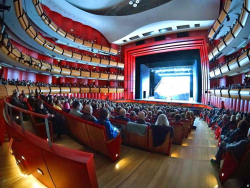Greek National Opera (SNFCC)

Greek National Opera (SNFCC)
Before 2017, the Greek National Opera was situated in the center of Athens, on Akadimias Street, and presented productions of high-quality operas, ballets, operettas, operas for children, recitals and concerts. The National Opera was founded in 1940. From then up to 1944, the company was operating as a part of the National Theater and giving performances in the historic neoclassical building in the scene of the Ziller theater - designed by the famous German architect Ernst Ziller, situated On on Agiou Konstantinou Street, in downtown Athens. In 1944, the company became a state-run corporation, extracted by the National Theater and presently functions as a private, state-funded organization. From 1959 to 1964, the repertory grew rapidly, with at least 20 productions every season. The company’s steady artistic development was interrupted by the military coup (Junta) of April 21st, 1967, and the National Opera was consolidated to the Hellenic National Theaters Union. In 1958, the newly-built Olympia Theater, found on Akadimias Street, was inaugurated with Verdi's "Aida". A total of almost 30 operas were introduced to the Greek audience for the first time. The Opera was highly supportive of Greek composers and artists, such as Maria Callas. This famous Greek soprano, internationally renowned for her celestial vocal range, had made her debut at the Herodes Atticus Odeon as well as at the Ancient Theater of Epidaurus.
Today, the National Opera co-produces operas with many of the world's leading opera houses. The building housing the Opera at the Stavros Niarchos Foundation has an area of 28,000 sqm and is one of the most modern worldwide. It combines aesthetics and superior acoustics with the latest technological features. Also, there is a smaller Alternative Stage, with a capacity of 400 persons for smaller events. Moreover, the Sacred Music Days and the Music Theater Days also debuted at the Alternative Stage through the transitional phase and now returns annually with enriched content.







